
Katydid
Date: 2022 Author: Jianhua Mo
Three species of katydids are found in the Riverina area, causing minor to occasionally important problems for citrus growers.
Description
Size and appearance: there are several katydid species, all resembling grasshoppers, with long antennae and large hind legs. The main species in Australia are the citrus katydid (Figure 1), inland katydid and spotted katydid (Figure 2).
Adults are 40–50 mm long. Adult citrus katydids and inland katydids are green. Adult spotted katydids are olive green and brown with dark‑brown markings on the wings and body.
Nymphs resemble adults but with shorter wings.
Life cycle: one generation a year. Eggs are laid from January to April. The nymphs hatch in early spring and begin feeding on newly‑set fruit in mid October to November while developing through 5 stages. Adult stage is reached during December and January.
Habit: Katydids live in young citrus foliage, flowers and fruit, and plants in bushland next to orchards. Adults fly strongly from tree to tree, resulting in patchy infestations.
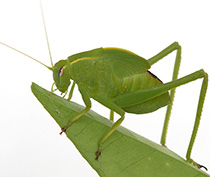
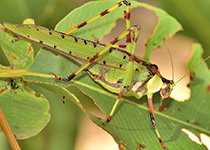
Damage
Nymphs and adults feed on citrus flowers, leaves and fruits up to 30 mm in diameter (petal fall to mid December). Feeding on fruits results in deep chalk-like scars on the fruit surface (Figures 3 and 4) and fruit drop. Damage is more common in oranges than in lemons, grapefruit or mandarins.
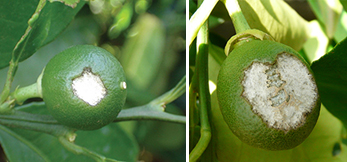

Natural predators
- Parasites: an unidentified tachinid fly species, and an unidentified wasp species.
- Predators: assassin bug (Figure 5), praying mantises (Figure 6), sphecid wasps and birds.
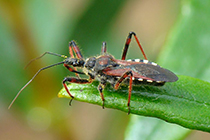
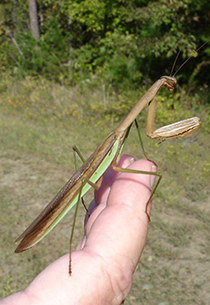
Monitoring
Monitor every 2 weeks from mid-September to late November. Check 5 randomly selected fruits from each of 5 randomly selected trees according to monitoring protocols for signs of damage and scan the foliage for insects. Use sticky trunk bands to monitor the numbers of emerging nymphs.
Control measures
Timely control is essential as small numbers of katydids can quickly cause considerable damage. Discuss IPM rates and strategies with your pest consultant.
Use a selective insecticide in areas of the orchard where the action threshold is exceeded. Check the APVMA PubCRIS database for registered controls.
Action should be taken when 5% or more fruits are showing fresh injury, or when sticky bands have more than 2 emerging nymphs per tree.

